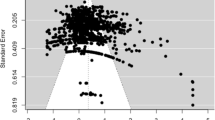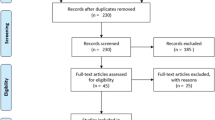Abstract
The purpose of this study was to evaluate the effects of an instructional procedure on the acquisition and generalization of metaphorical understanding for children with autism spectrum disorder. Three students (two boys, one girl, 5–8 years old) participated but only two completed the study. A multiple-probe design across two behaviors and three participants was used. The metaphors were categorized by topography: metaphors involving physical features and metaphors involving abstract properties. The instruction consisted of intraverbal training using echoic prompts, picture prompts, and textual prompts. The results indicated that the instruction was effective in establishing metaphorical understanding of target metaphors. Generalized understanding to untaught metaphors occurred for the two students who completed the study, and all metaphors were maintained at a relatively high level for two months following the instruction.


Similar content being viewed by others
References
American Psychiatric Association. (2013). Diagnostic and statistical manual of mental disorders (5thed.) (DSM-5). Washington, DC: Author.
Braam, S. J., & Poling, A. (1983). Development of intraverbal behavior in mentally retarded individuals through transfer of stimulus control procedures: classification of verbal responses. Applied Research in Mental Retardation, 4(4), 279–302.
Cameron, L. (2003). Metaphor in educational discourse. London, UK: Continuum.
Cicchetti, D. V. (1994). Guidelines, criteria, and rules of thumb for evaluating normed and standardized assessment instruments in psychology. Psychological Assessment, 6(4), 284–290.
Cortes, A. I. R., Cobos, F. J. M., & Tarbox, J. (2018). Teaching children to create metaphorical expressions. International Journal of Psychology & Psychological Therapy, 18(1), 27–38.
DeLeon, I. G., & Iwata, B. A. (1996). Evaluation of a multiple-stimulus presentation format for assessing reinforcer preferences. Journal of Applied Behavior Analysis, 29(4), 519–533. https://doi.org/10.1901/jaba.1996.29-519.
Feng, H., & Sun, W.-C. (2017). Tzu-pi cheng fa chan pen wei ping liang hsi tung [Developmentally-based behavior assessment system for children with autism]. Taipei, Taiwan: Hua-Teng Publisher.
Goldsmith, T. R., LeBlanc, L. A., & Sautter, R. A. (2007). Teaching intraverbal behavior to children with autism. Research in Autism Spectrum Disorders, 1(1), 1–13. https://doi.org/10.1016/j.rasd.2006.07.001.
Greer, R. D., & Speckman, J. (2009). The integration of speaker and listener responses: A theory of verbal development. Psychological Record, 59(3), 449–488.
Greer, R. D., & Ross, D. E. (2008). Verbal Behavior Analysis: Inducing and expanding new capacities in children with language delays. Boston, MA: Allyn & Bacon.
Hayes, S. C., Barnes-Holmes, D., & Roche, B. (2001). Relational frame theory: A post-Skinnerian account of human language and cognition. New York, NY: Kluwer Academic/Plenum Publishers.
Ledford, J. R., & Gast, D. L. (2018). Combination and other designs. In J. R. Ledford & D. L. Gast (Eds.), Single case research methodology: Applications in special education and behavioral sciences (3rd ed., pp. 334–364). New York, NY: Routledge.
Ledford, J. R., Lane, J. D., & Gast, D. L. (2018). Dependent variables, measurement, and reliability. In J. R. Ledford & D. L. Gast (Eds.), Single case research methodology: Applications in special education and behavioral sciences (3rd ed., pp. 97–132). New York, NY: Routledge.
Lu, J. P., Yang, Z. W., Shu, M. Y., & Su, L. Y. (2004). Er tong gu du zheng liang biao ping ding de xin du xiao du fen xi [Reliability and validity analysis of the Childhood Autism Rating Scale]. Zhong Guo Xian Dai Yi Xue Za Zhi, 14(3), 119–123.
Luciano, M. C. (1986). Acquisition, maintenance, and generalization of productive intraverbal behavior through transfer of stimulus control procedures. Applied Research in Mental Retardation, 7(1), 1–20.
Mashal, N., & Kasirer, A. (2011). Thinking maps enhance metaphoric competence in children with autism and learning disabilities. Research in Developmental Disabilities, 32(6), 2045–2054. https://doi.org/10.1016/j.ridd.2011.08.012.
Melogno, S., D’Ardia, C., Pinto, M. A., & Levi, G. (2012). Explaining metaphors in high-functioning Autism Spectrum Disorder children: A brief report. Research in Autism Spectrum Disorders, 6(2), 683–689. https://doi.org/10.1016/j.rasd.2011.09.005.
Michael, J., Palmer, D. C., & Sundberg, M. L. (2011). The multiple control of verbal behavior. Analysis of Verbal Behavior, 27(1), 3–22.
Miguel, C. F., Frampton, S. E., Lantaya, C. A., LaFrance, D. L., Quah, K., Meyer, C. S., . . . Fernand, J. K. (2015). The effects of tact training on the development of analogical reasoning. Journal of the Experimental Analysis of Behavior, 104(2), 96–118. doi:https://doi.org/10.1002/jeab.167
Persicke, A., Tarbox, J., Ranick, J., & St. Clair, M. (2012). Establishing metaphorical reasoning in children with autism. Research in Autism Spectrum Disorders, 6(2), 913–920. https://doi.org/10.1016/j.rasd.2011.12.007.
Rundblad, G., & Annaz, D. (2010). The atypical development of metaphor and metonymy comprehension in children with autism. Autism, 14(1), 29–46. https://doi.org/10.1177/1362361309340667.
Schopler, E., Reichler, R. J., & Renner, B. R. (2002). The childhood autism rating scale (CARS). Los Angeles, CA: Western Psychological Services.
Semino, E., & Demjén, Z. (2016). The Routledge handbook of metaphor and language. New York, NY: Routledge.
Skinner, B. F. (1957). Verbal behavior. New York, NY: Appleton-Century-Crofts.
Stewart, I., & Barnes-Holmes, D. (2001). Understanding metaphor: A relational frame perspective. The Behavior Analyst, 24(2), 191–199.
Watkins, M. W., & Pacheco, M. (2000). Interobserver agreement in behavioral research: Importance and calculation. Journal of Behavioral Education, 10(4), 205–212. https://doi.org/10.1023/A:1012295615144.
Wechsler, D. (2003). Wechsler Intelligence Scale for Children (4th ed.). San Antonio, TX: Psychological Corporation.
Wechsler, D. (1989). Wechsler Preschool and Primary Scale of Intelligence (Rev. ed.). San Antonio, TX: Psychological Corporation.
Zhang, H. C. (2008). Wei shi er tong zhi li liang biao-di si ban [The Wechsler Intelligence Scale for children (4thed.)]. Zhuhai, Guangdong, China: King-May Psychological Assessment Technology Development.
Zhang, H. C. (2009). Wei shi you er liang biao xiu gai ban de xin li xue ce liang fen xi [Psychometrical analysis of Chinese version of Wechsler Preschool and Primary Scale of Intelligence (Rev. ed.)]. Chinese Journal of Psychological Science, 15(5), 1–13.
Acknowledgements
This project was funded by the National Social Science Foundation, China (Grant Number: 19XSH020, PI: Sheng Xu).
Author information
Authors and Affiliations
Corresponding author
Ethics declarations
Disclosure of Potential Conflict of Interest
None of the authors involved in this study have any interests that might be interpreted as influencing the research.
Ethical Approval
All procedures performed in studies involving human participants were in accordance with the ethical standards of the institutional and/or national research committee and with the 1964 Helsinki declaration and its later amendments or comparable ethical standards.
Informed Consent
Informed consent was obtained from the parents of the children included in the study.
Additional information
Publisher’s Note
Springer Nature remains neutral with regard to jurisdictional claims in published maps and institutional affiliations.
Appendices
Appendix 1
Appendix 2
Rights and permissions
About this article
Cite this article
Lee, G.T., Xu, S., Zou, H. et al. Teaching Children with Autism to Understand Metaphors. Psychol Rec 69, 499–512 (2019). https://doi.org/10.1007/s40732-019-00355-4
Published:
Issue Date:
DOI: https://doi.org/10.1007/s40732-019-00355-4




